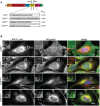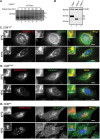Transmembrane domain quality control systems operate at the endoplasmic reticulum and Golgi apparatus
- PMID: 28384259
- PMCID: PMC5383021
- DOI: 10.1371/journal.pone.0173924
Transmembrane domain quality control systems operate at the endoplasmic reticulum and Golgi apparatus
Abstract
Multiple protein quality control systems operate to ensure that misfolded proteins are efficiently cleared from the cell. While quality control systems that assess the folding status of soluble domains have been extensively studied, transmembrane domain (TMD) quality control mechanisms are poorly understood. Here, we have used chimeras based on the type I plasma membrane protein CD8 in which the endogenous TMD was substituted with transmembrane sequences derived from different polytopic membrane proteins as a mode to investigate the quality control of unassembled TMDs along the secretory pathway. We find that the three TMDs examined prevent trafficking of CD8 to the cell surface via potentially distinct mechanisms. CD8 containing two distinct non-native transmembrane sequences escape the ER and are subsequently retrieved from the Golgi, possibly via Rer1, leading to ER localisation at steady state. A third chimera, containing an altered transmembrane domain, was predominantly localised to the Golgi at steady state, indicating the existence of an additional quality control checkpoint that identifies non-native transmembrane domains that have escaped ER retention and retrieval. Preliminary experiments indicate that protein retained by quality control mechanisms at the Golgi are targeted to lysosomes for degradation.
Conflict of interest statement
Figures







Similar articles
-
Endoplasmic reticulum quality control of unassembled iron transporter depends on Rer1p-mediated retrieval from the golgi.Mol Biol Cell. 2004 Mar;15(3):1417-24. doi: 10.1091/mbc.e03-10-0765. Epub 2003 Dec 29. Mol Biol Cell. 2004. PMID: 14699055 Free PMC article.
-
Short transmembrane domains target type II proteins to the Golgi apparatus and type I proteins to the endoplasmic reticulum.J Cell Sci. 2024 Aug 1;137(15):jcs261738. doi: 10.1242/jcs.261738. Epub 2024 Aug 8. J Cell Sci. 2024. PMID: 38973735
-
Membrane protein retrieval from the Golgi apparatus to the endoplasmic reticulum (ER): characterization of the RER1 gene product as a component involved in ER localization of Sec12p.Mol Biol Cell. 1995 Nov;6(11):1459-77. doi: 10.1091/mbc.6.11.1459. Mol Biol Cell. 1995. PMID: 8589449 Free PMC article.
-
Bring it back, bring it back, don't take it away from me - the sorting receptor RER1.J Cell Sci. 2020 Sep 1;133(17):jcs231423. doi: 10.1242/jcs.231423. J Cell Sci. 2020. PMID: 32873699 Review.
-
Control of cystic fibrosis transmembrane conductance regulator membrane trafficking: not just from the endoplasmic reticulum to the Golgi.FEBS J. 2013 Sep;280(18):4396-406. doi: 10.1111/febs.12392. Epub 2013 Jul 5. FEBS J. 2013. PMID: 23773658 Review.
Cited by
-
Maintaining Golgi Homeostasis: A Balancing Act of Two Proteolytic Pathways.Cells. 2022 Feb 23;11(5):780. doi: 10.3390/cells11050780. Cells. 2022. PMID: 35269404 Free PMC article. Review.
-
The glycan-dependent ERAD machinery degrades topologically diverse misfolded proteins.Plant J. 2018 Apr;94(2):246-259. doi: 10.1111/tpj.13851. Epub 2018 Mar 14. Plant J. 2018. PMID: 29396984 Free PMC article.
-
Synaptic Vesicle Recycling and the Endolysosomal System: A Reappraisal of Form and Function.Front Synaptic Neurosci. 2022 Feb 25;14:826098. doi: 10.3389/fnsyn.2022.826098. eCollection 2022. Front Synaptic Neurosci. 2022. PMID: 35280702 Free PMC article. Review.
-
Isoform-dependent lysosomal degradation and internalization of apolipoprotein E requires autophagy proteins.J Cell Sci. 2022 Jan 15;135(2):jcs258687. doi: 10.1242/jcs.258687. Epub 2022 Jan 25. J Cell Sci. 2022. PMID: 34982109 Free PMC article.
-
Molecular Phenotypes Segregate Missense Mutations in SLC13A5 Epilepsy.J Mol Biol. 2024 Nov 15;436(22):168820. doi: 10.1016/j.jmb.2024.168820. Epub 2024 Oct 22. J Mol Biol. 2024. PMID: 39442909 Free PMC article.
References
-
- Wallin E, von Heijne G. Genome-wide analysis of integral membrane proteins from eubacterial, archaean, and eukaryotic organisms. Protein Sci. 1998;7(4):1029–38. Epub 1998/05/06. PubMed Central PMCID: PMCPmc2143985. doi: 10.1002/pro.5560070420 - DOI - PMC - PubMed
-
- Braakman I, Hebert DN. Protein folding in the endoplasmic reticulum. Cold Spring Harb Perspect Biol. 2013;5(5):a013201 Epub 2013/05/03. doi: 10.1101/cshperspect.a013201 - DOI - PMC - PubMed
-
- Guo Y, Sirkis DW, Schekman R. Protein Sorting at the trans-Golgi network. Annu Rev Cell Dev Biol. 2014;30:169–206. Epub 2014/08/26. doi: 10.1146/annurev-cellbio-100913-013012 - DOI - PubMed
-
- Babst M. Quality control: quality control at the plasma membrane: one mechanism does not fit all. J Cell Biol. 2014;205(1):11–20. Epub 2014/04/16. PubMed Central PMCID: PMCPmc3987138. doi: 10.1083/jcb.201310113 - DOI - PMC - PubMed
-
- Koenig PA, Ploegh HL. Protein quality control in the endoplasmic reticulum. F1000Prime Rep. 2014;6:49 Epub 2014/09/04. PubMed Central PMCID: PMCPmc4108957. doi: 10.12703/P6-49 - DOI - PMC - PubMed
MeSH terms
Grants and funding
LinkOut - more resources
Full Text Sources
Other Literature Sources
Research Materials

